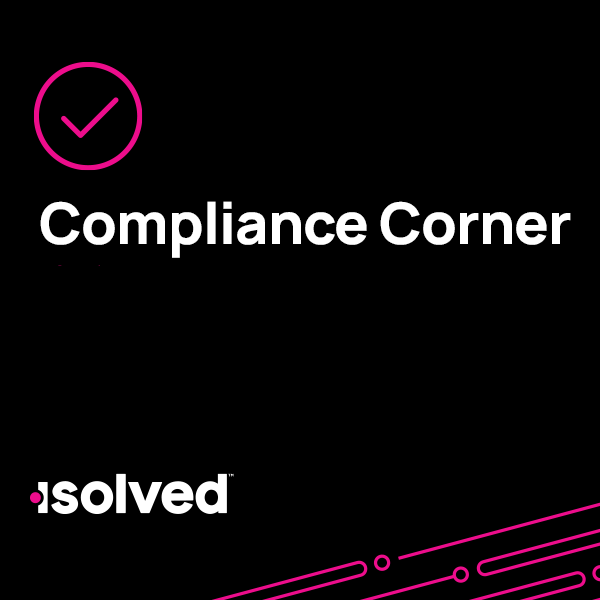Compliance Corner: Navigating the Complexities of FMLA
Thursday February 29th, 2024
Estimated time to read: 4 minutes

The Family and Medical Leave Act (FMLA) has been a cornerstone of U.S. labor law since its enactment in 1993, safeguarding employees' rights to unpaid, job-protected leave for specified family and medical reasons. With the landscape of work continually evolving, staying abreast of FMLA requirements is paramount for employers. Here’s what you need to know about FMLA and how to ensure compliance.
Key Aspects for Employers
What are the FMLA entitlements?
Eligible employees are entitled to 12 work weeks of leave in a 12-month period for reasons such as the birth of a child, to care for an immediate family member with a serious health condition or for their own serious health condition. Additionally, for military families, FMLA includes specific provisions allowing for up to 26 weeks of leave to care for a covered service member with a serious injury or illness.
How does FMLA leave work for spouses employed by the same employer?
When spouses work for the same employer, FMLA provisions allow employers to limit their combined leave to 12 work weeks within a 12-month period for birth, adoption or foster care. However, each spouse may take the full 12 weeks separately if they are caring for the health of a spouse, parent, child or themselves. For military caregiver leave, both spouses are entitled to the full 26 work weeks individually.
What are employer obligations under FMLA?
Employers are tasked with several responsibilities under FMLA, including:
- Notifying Employees: Employers must inform employees of their FMLA rights by displaying an informative poster in a conspicuous place and including the information in employee handbooks or manuals.
- Eligibility and Rights and Responsibilities Notification: Upon receiving a leave request, employers must notify employees whether they are eligible for FMLA leave within five business days along with a written notice detailing the specific expectations of the employee taking FMLA leave. This notice provides essential information to employees about their entitlements and obligations under FMLA. It outlines key aspects such as leave entitlements, conditions for using paid leave, the requirement for medical certification and the potential consequences of leave denial. Additionally, it informs employees of their rights upon return to work and their responsibilities, including providing timely notice of leave needs and informing the employer of any changes.
- Designation Notice: Crucially, employers are also required to inform employees whether the leave has been designated as FMLA leave. This designation notice must be provided within five business days after the employer has enough information to determine whether the leave is being taken for an FMLA-qualified reason. The designation notice is a crucial step in the FMLA process, as it formally informs the employee that their leave will be designated as FMLA-protected, ensuring that their absence is recognized under the 12-week FMLA entitlement.
What protections and restoration rights does FMLA provide to employees?
Job protection and restoration are fundamental aspects of FMLA, ensuring that eligible employees can take leave without fear of losing their jobs and are entitled to return to the same position or an equivalent one upon their return to work. Under FMLA regulations, employers must guarantee job protection for the duration of an employee's FMLA leave.
Upon returning from FMLA leave, employees are entitled to be restored to their original position or an equivalent one with equivalent pay, benefits and terms of employment. However, there are certain exceptions to this rule. For instance, if the employee would not have remained employed even if they had not taken FMLA leave (e.g., due to a layoff or restructuring), the employer is not obligated to reinstate the employee. Additionally, if the employee's position has changed significantly during their FMLA leave and they are unable to perform the essential functions of their original job, the employer may place them in an equivalent position for which they are qualified.
Have there been any recent changes to the FMLA?
While the core provisions of FMLA have remained consistent, there have been adjustments and clarifications over the years to address emerging workplace needs and societal changes. One significant clarification made by the Department of Labor (DOL) is that employees with serious, chronic health conditions can limit their workday hours indefinitely beyond a 12-month period, provided they do not exhaust their FMLA leave entitlement. Additionally, it has been confirmed that remote employees are eligible for FMLA leave, ensuring that the act's protections extend to the evolving nature of the workforce.
What role do state laws play in the FMLA leave process?
FMLA does not preempt state laws, and several states have enacted their own leave laws that expand upon the federal FMLA protections. These state laws may offer greater leave rights, cover smaller employers or provide paid leave options. Employers operating in multiple states must comply with both federal and state leave laws, adhering to the more generous provisions when there is a difference.
What strategies can employers use to ensure compliance?
Staying compliant with FMLA involves a proactive approach:
- Education and Training: Ensure that HR personnel and managers are well-versed in FMLA regulations and the nuances of state laws.
- Clear Policies: Develop and maintain clear, written leave policies that are easily accessible to employees.
- Consistent Application: Apply FMLA policies consistently to all employees to avoid claims of discrimination or retaliation.
- Recordkeeping: Keep detailed records of all FMLA leave requests, notices, certifications and timekeeping to ensure compliance and to defend against potential claims.
As FMLA continues to evolve, employers must remain vigilant, ensuring their policies and practices adapt accordingly. By understanding the act's requirements, keeping abreast of legal changes, and implementing a structured approach to leave management, employers can confidently navigate FMLA complexities and foster a supportive workplace culture while maintaining compliance.
Navigating the complexities of FMLA administration can be challenging for many organizations. Consider leveraging the expertise of a specialized leave services team to handle FMLA matters efficiently and accurately. By partnering with a trusted provider, employers can streamline leave management processes, reduce administrative burdens and mitigate compliance risks. With dedicated professionals overseeing FMLA administration, employers can rest assured that their leave programs are in capable hands, allowing them to focus on their core business objectives with confidence.
Is your organization staying up to date with FMLA? Our HR Services team can help.

About Diana Vinalet:
Diana is part of isolved’s HR Services team and has more than 12 years of experience in HR. Her areas of expertise include leave administration, benefits, employee relations, policy development, and compliance in all 50 states (and Canada). Throughout her career, Diana has worked within insurance, sales, finance, hospitality, manufacturing, childcare and medical industries; the majority dealing with people operations and management in some capacity.
